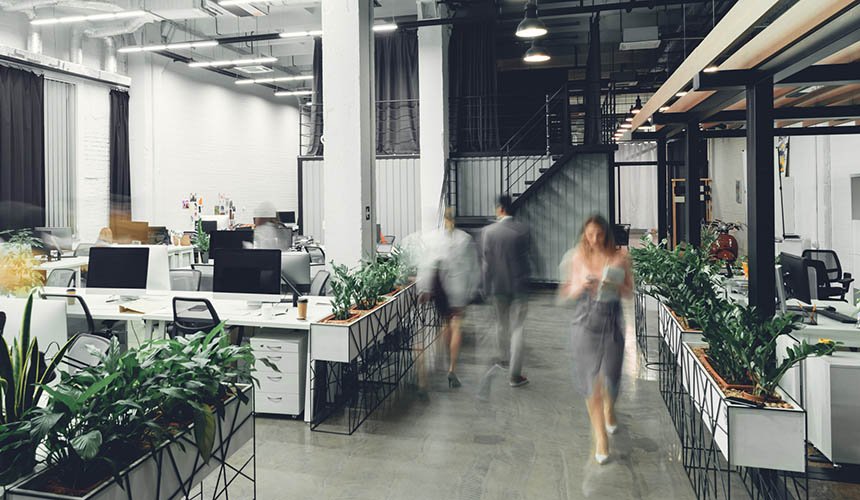Picture entering a thoughtfully designed workspace filled with motivational and inviting energy. That’s how employees want to feel in their work environment—welcome and motivated. A well-designed area helps them thrive, promotes collaboration, and boosts productivity.
Likewise, inspired employees often produce high-quality work, leading to a positive impact on the business. In addition, providing a welcoming atmosphere can reduce turnover, as content staff are likely to stay loyal in the long run.
Ultimately, a good workspace acts as a solid foundation for business growth. Combining aesthetics, functionality, and ergonomics may help keep employees engaged. In essence, creating an ideal workspace is an investment in future business success.
As an employer, you may wonder how to nurture the perfect workspace. If so, continue reading this article for insightful tips to enhance your team’s work experience.
Table of Contents
Assessing Employees Needs
Creating the ideal workspaces for professionals begins by understanding employees’ needs. One approach is to conduct collecting feedback about work environment preferences through surveys or interviews. Involvement from both management and staff in decision-making also fosters a sense of ownership and appreciation.
Also, it’s vital to consider job roles within the organization when optimizing your workplace design. For instance, a public relations team may need a dedicated area for meetings and brainstorming sessions. Alternatively, software developers prefer an isolated area with ample room for hardware. By customizing office layouts to cater to these specific roles, employees may feel satisfied or fulfilled, without feeling any sense of lacking.
Choosing The Right Office Layout
Recognizing each employee’s unique working style is crucial when designing a workspace. Consider these office layouts to accommodate diverse needs:
- Open office plans remove boundaries among employees and encourage collaboration. If implemented thoughtfully, they can foster creativity and camaraderie.
- Private offices are suitable for workers seeking a quiet workspace to concentrate on tasks that require focus. These offices also offer privacy and minimize disruptions, promoting a productive work environment.
- Cubicles offer a middle ground between open spaces and private workstations. They preserve some personal space for employees and a certain level of privacy.
- Hybrid layouts combine elements of traditional office setups with more flexible and collaborative areas, catering to different working styles. Likewise, they promote collaboration while still allowing for privacy when required.
A well-made workspace design and build demonstrates your support for the diverse needs of your workforce, boosting productivity while encouraging overall wellness.
Incorporating Ergonomic Design
Ergonomic design plays a crucial role in workers’ productivity and comfort. Customizable chairs and tables provide ease. Likewise, suitable lighting and temperature can prevent eye strain and maintain high energy. Wrists and footrests may provide extra support by lessening discomfort and protecting against occupational overuse syndrome (OOS).
Moreover, consider the positioning and placement of computers, keyboards, and phones. Proper positioning improves posture while reducing strain, which boosts comfort and work efficiency. In short, shifting to ergonomic solutions could promote a healthy workspace while reducing the risk of injury.

Designing Spaces For Relaxation And Mental Health
In addition to the physical aspect, designing spaces to boost mental health is essential. Outdoor areas like terraces or green spaces offer employees a chance to take breaks surrounded by nature. Quiet rooms or meditation areas also help workers ease their minds during the work shift.
Aside from that, you can install break rooms and recreational facilities. These spaces allow employees to unwind and engage in recreational activities, relieving stress and boosting camaraderie. Ensuring plenty of natural light and outdoor views also positively impacts workers’ mood and productivity.
Furthermore, consider incorporating biophilic design elements, such as plants and natural materials. These elements make workspaces feel more welcoming and support employee well-being. By embracing such design choices, your company can build a nurturing environment that fosters relaxation.
Continuously Improving And Evaluating
Consistent evaluation and enhancement are vital in maintaining the perfect workspace for employees. This process includes periodic check-ins or surveys addressing workspace-related concerns, like lighting and noise levels. Encouraging open communication and seeking staff feedback can reveal vital improvement areas.
Lastly, tracking metrics, like productivity and turnover rates, is best, as it gauges the effects of the modification. Analyzing these factors allows you to comprehend the impact of the new workspace. In that way, you can adapt to the changing needs of your workforce, technological progress, and industry shifts.
Final Thoughts
Building the perfect workspace for employees can boost productivity, well-being, and safety. To summarize, an effective workspace integrates ergonomics, natural lighting, and options for teamwork and solitude into its design. Focusing on these factors showcases your genuine concern for team member performance and retention rates.
Consequently, it’s essential to consider staff satisfaction while fine-tuning office setups. A workspace that caters to the preferences of your employees could be a driving force behind your organization’s success.










